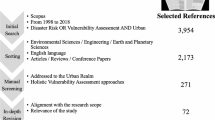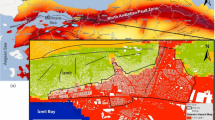Abstract
Researchers have recently examined the geographic variability of the vulnerability of populations to earthquakes. These studies focus mainly on the complex modelling of geophysical processes or identification of socio-economically disadvantaged populations. However, no studies to date have integrated different components of vulnerability with metrics of travel distance to hospitals and trauma centres (systemic vulnerability). We argue that this previously unaccounted component is an important conceptual and practical aspect of earthquake vulnerability. Accordingly, this paper presents a multi-criteria model for combining physical, social, and systemic components, moving towards a more comprehensive assessment of vulnerability. An analytic hierarchy process is used to produce a place-specific index of social vulnerability, which we combine with soil liquefaction and amplification index and a road network model for access to hospitals and trauma services. Using a geographic information system, we implemented this model for the Greater Victoria region (483 km2, 2011 population: 345,000) in British Columbia, Canada. Clustering of total vulnerability was found in outlying areas, highlighting the importance of access to trauma centres. We conclude by identifying challenges in measuring earthquake vulnerability and advocate integration of systemic vulnerability components in natural hazards research.



Similar content being viewed by others
References
Akgun A, Türk N (2010) Landslide susceptibility mapping for Ayvalik (Western Turkey) and its vicinity by multicriteria decision analysis. Environ Earth Sci 61:595–611
Amram O, Schuurman N, Hameed SM (2011) Mass casualty modelling: a spatial tool to support triage decision making. Int J Health Geogr 10:40
Anbazhagan P, Thingbaijam KKS, Nath SK, Narendara Kumar JN, Sitharam TG (2010) Multi-criteria seismic hazard evaluation for Bangalore city, India. J Asian Earth Sci 38:168–198
Armaş I (2008) Social vulnerability and seismic risk perception. Case study: the historic center of the Bucharest Municipality, Romania. Nat Hazards 47:397–410
Armaş I, Rădulian M (2014) Spatial multi-criteria risk assessment of earthquakes from Bucharest, Romania. In: Bostenaru DM, Armaş I, Goretti A (eds) Environmental hazards, earthquake hazard impactt and urban planning. Springer, Heidelberg, pp 127–149
Atwater BF, Tuttle MP, Schweig ES, Rubin CM, Yamaguchi DK, Hemphill-Haley E (2003) Earthquake recurrence inferred from paleoseismology. Dev Quarternary Sci 1:331–350
Bell N, Schuurman N, Oliver L, Hayes MV (2007) Towards the construction of place-specific measures of deprivation: a case study from the Vancouver metropolitan area. Can Geogr 51:444–461
Brabyn L, Skelly C (2002) Modeling population access to New Zealand public hospitals. Int J Health Geogr 1:3. doi:10.1186/1476-072X-1-3
Cascadia Region Earthquake Workgroup (2011) History of earthquakes in Cascadia. Cascadia Region Earthquake Workgroup, Portland
Castellanos Abella EA, Van Westen CJ (2007) Generation of a landslide risk index map for Cuba using spatial multi-criteria evaluation. Landslides 4:311–325
Chakraborty J, Tobin G, Montz B (2005) Population evacuation: assessing spatial variability in geophysical risk and social vulnerability to natural hazards. Nat Hazards Rev 6:23–33
Chateau D, Metge C, Prior H, Soodeen RA (2012) Learning from the census: the Socio-Economic Factor Index (SEFI) and health outcomes in Manitoba. Can J Public Health 103:523–527
Chiba M (2011) Warning and evacuation in response to sediment-related disasters. Nat Hazards 56:499–507
Chou YJ, Huang N, Lee CH, Tsai SL, Chen LS, Chang HJ (2004) Who is at risk of death in an earthquake? Am J Epidemiol 160:688–695
Clague JJ (1997) Evidence for large earthquakes at the Cascadia subduction zone. Rev Geophys 35:439–460
Clague JJ (2002) The earthquake threat in southwestern British Columbia: a geologic perspective. Nat Hazards 26:7–33
Clague JJ, Munro A, Murty M (2003) Tsunami hazard and risk in Canada. Nat Hazards 28:433–461
Cova T, Church RL (1997) Modelling community evacuation vulnerability using GIS. Int J Geogr Inf Sci 11:763–784
Cutter S, Boruff B, Shirley W (2003) Social vulnerability to environmental hazards. Soc Sci Q 84:242–261
Dell’Acqua F, Gamba P, Jaiswal K (2013) Spatial aspects of building and population exposure data and their implications for global earthquake exposure monitoring. Nat Hazards 68:1291–1309
Delor F, Hubert M (2000) Revisiting the concept of ‘vulnerability’. Soc Sci Med 50:1557–1570
Douglas J (2007) Physical vulnerability modelling in natural hazard risk assessment. Nat Hazards Earth Syst Sci 7:283–288
Duzgun HSB, Yucemen MS, Kalacioglu HS, Celik K, Kemec S, Ertugay K, Deniz A (2011) An integrated earthquake vulnerability assessment framework for urban areas. Nat Hazards 59:917–947
Ehrlich D, Kemper T, Blaes X, Soille P (2013) Extracting building stock information from optical satellite imagery for mapping earthquake exposure and its vulnerability. Nat Hazards 68:79–95
Feizizadeh B, Blaschke T (2013) GIS-multicriteria decision analysis for landslide susceptibility mapping: comparing three methods for the Urmia Lake Basin, Iran. Nat Hazards 65:2105–2128
Fekete A (2012) Spatial disaster vulnerability and risk assessments: challenges in their quality and acceptance. Nat Hazards 61:1161–1178
Few R (2007) Health and climatic hazards: framing social research on vulnerability, response, and adaptation. Glob Environ Chang 17:281–295
Flanagan BE, Gregory EW, Hallisey EJ, Heitgard JL, Lewis B (2011) A social vulnerability index for disaster management. J Homel Secur Emerg Manag 8:1547–7355
Frankel AD, Petersen MD (2008) Cascadia subduction zone. In: The uniform California earthquake rupture forecast, version 2. US Geol Surv, Renton
Gitis V, Derendyaev A, Metrikov P, Shogin A (2012) Network geoinformation technology for seismic hazard research. Nat Hazards 62:1021–1036
Goldfinger C, Nelson CH, Morey A, Johnson JE, Gutierrez-Pastor J, Eriksson AT, Karabanov E, Patton J, Gracia E, Enkin R, Dallimore A, Dunhill G, Vallier T (2012) Turbidite event history: methods and implications for Holocene paleoseismicity of the Cascadia subduction zone. US Geol Surv Prof Pap 1661-F
Guha-Sapir D, Vos F, Below R, Ponserre S (2011) Annual disaster statistical review 2010: The numbers and trends. Cen Res Epidemiol Disasters. Université catholique de Louvain, Brussels.
Hengjian L, Kohiyama M, Horie K, Maki N, Hayashi H, Tanaka S (2003) Building damage and casualties after an earthquake. Nat Hazards 29:387–403
Hewitt K (2013) Environmental disasters in social context: toward a preventive and precautionary approach. Nat Hazards 66:3–14
Horner MW, Widener MJ (2011) The effects of transportation network failure on people’s accessibility to hurricane disaster relief goods: a modeling approach and application to a Florida case study. Nat Hazards 59:1619–1634
King D, MacGregor C (2000) Using social indicators to measure community vulnerability to natural hazards. Aust J Emerg Manag 15:52–57
Kuhlicke C, Scolobig A, Tapsell S, Steinfuhrer A, Di Marchi B (2011) Contextualizing social vulnerability: findings from case studies across Europe. Nat Hazards 58:789–810
Kulkarni R, Wong I, Zachariasen J, Goldfinger C, Lawrence M (2013) Statistical analyses of great earthquake recurrence along the Cascadia Subduction Zone. Bull Seismol Soc Amer 103:3205–3321
Lindsay J (2003) The determinants of disaster vulnerability: achieving sustainable mitigation through population health. Nat Hazards 28:291–304
Luo W, Wang F (2003) Measures of spatial accessibility to health care in a GIS environment: synthesis and a case study in the Chicago region. Environ Plan B Plan Des 30:865–884
Malczewski J (1999) Spatial multicriteria decision making. In: Thill JC (ed) Spatial multicriteria decision making and analysis: a geographic information sciences approach. Ashgate, Brookfield, pp 11–48
Martins VN, Sousa e Silva D, Cabral P (2012) Social vulnerability assessment to seismic risk using multicriteria analysis: the case study of Vila Franca do Campo. Nat Hazards 62:385–404
McLafferty SL (2003) GIS and health care. Ann Rev Public Health 24:25–42
Monahan P, Levson V, Henderson P, Sy A (2000) Relative liquefaction and amplification of ground motion hazard maps of Greater Victoria. BC Geol Surv, Victoria
Morrow BH (1999) Identifying and mapping community vulnerability. Disasters 23:1–18
Mück M, Taubenböck H, Post J, Wegscheider S, Strunz G, Sumaryono S, Ismail FA (2013) Assessing building vulnerability to earthquake and tsunami hazard using remotely sensed data. Nat Hazards 68:97–114
Nallamothu BK, Bates E, Wang Y, Bradley E, Krumholz H (2006) Driving times and distances to hospitals with percutaneous coronary intervention in the United States: implications for prehospital triage of patients with ST-elevation myocardial infarction. Circulation 113:1189–1195
National Earthquake Database (2014) Seismic hazard earthquake epicentre file. Geol Surv Can Ottawa, Ottawa, ON. www.earthquakescanada.nrcan.gc.ca/stndon/NEDB-BNDS/bull-eng.php. Accessed 19 Mar 2014
Natural Resources Canada (2013) Seismic zones in western Canada. Natural Resour Can, Ottawa, ON. http://www.earthquakescanada.nrcan.gc.ca/zones/westcan-eng.php Accessed 13 Mar 2014
Noriega GR, Ludwig LG (2012) Social vulnerability assessment for mitigation of local earthquake risk in Los Angeles County. Nat Hazards 64:1341–1355
Onur T, Ventura CE, Finn WDL (2006) A comparison of two regional seismic damage estimation methodologies. Can J Civil Eng 33:1401–1409
Oregon Department of Geology and Mineral Industries (2013) Earthquake hazards in the Pacific Northwest. Oregon Dep Geol Mineral Industries, Portland
Pathak SR, Dalvi AN (2013) Elementary empirical model to assess seismic soil liquefaction. Nat Hazards 69:425–440
Peleg K, Pliskin JS (2004) A geographic information system simulation model of EMS: reducing ambulance response time. Am J Emerg Med 22:164–170
Pourghasemi HR, Pradhan B, Gokceoglu C, Deylami Moezzi K (2012) Landslide susceptibility mapping using a spatial multi criteria evaluation model at Haraz Watershed, Iran. Springer, Heidelberg
Rashed T, Weeks J (2003) Assessing vulnerability to earthquake hazards through spatial multicriteria analysis of urban areas. Int J Geog Inf Sci 17:547–576
Rygel L, O’Sullivan D, Yarnal B (2006) A method for constructing a social vulnerability index: an application to hurricane storm surges in a developed country. Mitig Adapt Strateg Glob Change 11:741–764
Saatay TL (1994) How to make a decision: the analytic hierarchy process. Interfaces 24:19–43
Scheuer S, Haase D, Meyer V (2011) Exploring multicriteria flood vulnerability by integrating economic, social and ecological dimensions of flood risk and coping capacity: from a starting point view towards an end point view of vulnerability. Nat Hazards 58:731–751
Schmidtlein MC, Deutsch R, Pieogorsch W, Cutter S (2008) A sensitivity analysis of the social vulnerability index. Risk Anal 28:1099–1115
Schmidtlein MC, Shafer M, Berry M, Cutter S (2011) Modeled earthquake losses and social vulnerability in Charleston, South Carolina. Appl Geogr 31:269–281
Schuurman N, Bérubé M, Crooks VA (2010) Measuring potential spatial access to primary health care physicians using a modified gravity model. Can Geogr 54:29–45
Sica S, Dello Russo A, Rotili F, Simonelli AL (2014) Ground motion amplification due to shallow cavities in nonlinear soils. Nat Hazards 71:1913–1935
Smith K (2013) Environmental hazards: assessing risk and reducing disaster. Routledge, NY
Ventura CE, Liam Finn WDL, Onur T, Blanquera A, Rezai M (2005) Regional seismic risk in British Columbia: classification of buildings and development of damage probability functions. Can J Civil Eng 32:372–387
Wisner B, Luce HR (1993) Disaster vulnerability: scale, power, and daily life. GeoJournal 30:127–140
Wood NJ, Schmidtlein MC (2012) Anisotropic path modeling to assess pedestrian-evacuation potential from Cascadia-related tsunamis in the US Pacific Northwest. Nat Hazards 62:275–300
Xie J, Nistor I, Murty T (2012) Tsunami risk for Western Canada and numerical modelling of the Cascadia fault tsunami. Nat Hazards 60:149–159
Xu Z, Lu X, Guan H, Han B, Ren A (2014) Seismic damage simulation in urban areas based on a high-fidelity structural model and a physics engine. Nat Hazards 71:1679–1693
Xue X, Yang X (2014) Seismic liquefaction potential assessed by fuzzy comprehensive evaluation method. Nat Hazards 71:2101–2112
Youssef AM, Pradhan B, Tarabees E (2011) Integrated evaluation of urban development suitability based on remote sensing and GIS techniques: contribution from the analytic hierarchy process. Arab J Geosci 4:463–473
Yu L, Lai KK (2011) A distance-based group decision-making methodology for multi-person multi-criteria emergency decision support. Decis Support Syst 51:307–315
Zhang N, Huang H, Su B, Zhang H (2013) Population evacuation analysis: considering dynamic population vulnerability distribution and disaster information dissemination. Nat Hazards 69:1629–1646
Acknowledgments
The authors gratefully acknowledge the assistance of Fiona Lawson at the Vancouver Island Health Authority.
Author information
Authors and Affiliations
Corresponding author
Rights and permissions
About this article
Cite this article
Walker, B.B., Taylor-Noonan, C., Tabbernor, A. et al. A multi-criteria evaluation model of earthquake vulnerability in Victoria, British Columbia. Nat Hazards 74, 1209–1222 (2014). https://doi.org/10.1007/s11069-014-1240-2
Received:
Accepted:
Published:
Issue Date:
DOI: https://doi.org/10.1007/s11069-014-1240-2




